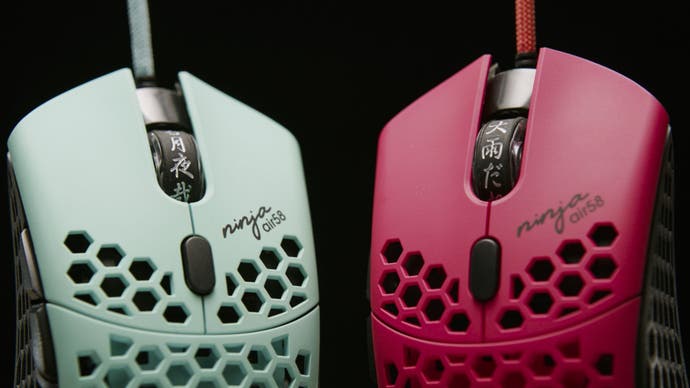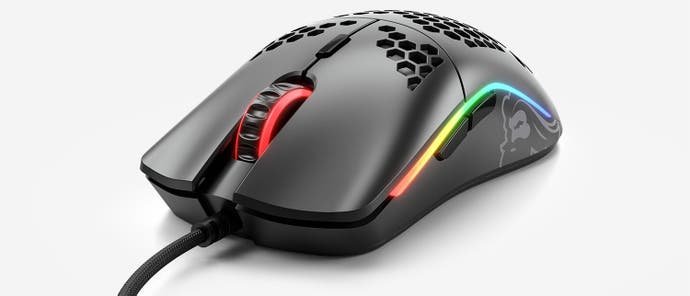Ultra-light 'honeycomb' mice are the next big thing in PC gaming gear
Arriving fashionably light.
We recently crowned the Glorious Model O as the best gaming mouse on the market. This ultra-light mouse, weighing only 67 grams, is part of a new breed that use honeycomb-like designs to save weight and flexible cables to minimise drag. The result is a uniquely responsive feel that makes it easy to aim accurately at low DPI settings, while still being able to make bigger 'flick' movements to engage enemies behind you. You also get a unique look, making these new mice easy to identify compared to their traditional counterparts.
Given the potential benefits they offer, it's no surprise that these ultra-lights have caught the attention of esports pros, streamers and enthusiasts alike over the past few months. But who has been driving the adoption of these honeycomb mice, why have they become popular now and what's coming next? We spoke to key individuals behind the scenes to find out.
Let's start with the basics: why are we even talking about ultra-light mice anyway? One answer lies in the reach of professional gamers on Twitch and YouTube, who are also natural early adopters - and promoters - of PC gaming tech, as we saw with the rise of mechanical keyboards around 2010. Twitch and YouTube star Ninja started using and promoting the Finalmouse Air58 mouse late last year, lending the mouse his name and making it a hot commodity amongst his many fans.

Ultra-light mice have also appeared in the hands of esports pros in games like Counter-Strike and Overwatch, with Vini of Furia Gaming recently sporting a Model O in the team's second-place ECS CSGO Season 7 finish. We spoke to consultant Lee working for Chinese peripherals firm G-Wolves, who agreed that the trend can be largely attributed to the growing success of fast-paced esports titles.
"I think that [ultra-light mice are] inseparable from the global development of esports in recent years... FPS is one of the most important categories in esports, with new games like Overwatch, PUBG and Fortnite. These shooting games have fast movement and subtle mouse control. In recent years, relatively small brands have begun to discover this problem and now big brands have finally noticed the many factors that make lightweight mice popular."

Alongside the influencers and esports pros, there's also a small but vocal enthusiast community, with users who have shared their own weight-saving modifications and 3D-printed mouse bodies on the /r/mousereview subreddit for years. In fact, it was these fans that influenced Glorious CEO Shazim Mohammad to create the Model O. He says that Glorious "took a niche idea and made it available to everyone... we saw no company was innovating in the mouse industry, and those that were innovating were going the wrong way..."
Now that ultra-light models are available in mainstream stores, these mavens have begun recommending ultra-light designs on related subreddits like r/buildapc, which in turn influence build guides and other content that drives purchases.
There's also a technology-driven angle to the ultra-light trend. In short, ultra-lights are becoming popular now because many of the classic problems with gaming mice have been solved, but the perfect weight is still an open question. For example, many mice used to come with cheap laser sensors that exhibited tracking or skipping problems when used at high speeds, but these have largely been replaced by cheap and reliable high-DPI optical sensors. Experimental shapes have similarly fallen by the wayside, with most mice offering a safe and comfortable design that accommodates most hand sizes. With the basics ticked off, weight is the next obvious point of differentiation, where research into design and materials can result in a noticeably better experience.
Ultra-light mouse makers Patrick and Dominik Schmalzried unsurprisingly agree, stating that "gamers [now] realize that gimmicky features that increase the weight are bad, and that low weight has actual performance advantages: you can move an ultra-light mouse quicker... our core belief is that low weight is the single most important feature of a gaming mouse."

The Glorious Model O we mentioned earlier is typical of modern ultra-light designs, with an immediately recognisable honeycomb structure used instead of a solid shell. These holes along the top and bottom reduce weight considerably, but the ABS plastic endoskeleton and hexagonal cut-outs mean the mouse still feels well-constructed - Shazim says that "tons of planning went into the structure and design to achieve a solid shape with holes." A less visible but equally important element is the mouse cable. Rather than a braided design, an incredibly flexible and light material similar to paracord is used, giving the mouse almost a wireless feel. A modern optical sensor capable of tracking at high speeds and low-friction PTFE feet complete the package.
It sounds silly but shedding the weight and upgrading these key components can make a big difference when it comes to in-game accuracy. From our testing of the 67g Model O and other light mice like the 80g Logitech G Pro Wireless, we saw a small but significant improvement in accuracy after an initial adjustment period of a few days. This is most noticeable on 'flick' shots, where you must use your muscle memory and reaction speed to quickly aim and fire on a target that's entered your field of view. These mice also look different too, making them a nice way to sidestep the current RGB arms race - even if they may let in dust or upset trypophobia sufferers.
While the Glorious Model O and the Finalmouse Air58 Ninja have captured the most headlines, they're soon to be one of many ultra-light options. Swedish gaming brand Xtrfy, an offshoot of the esports team Ninjas in Pyjamas, spoofed the ultra-light movement with a video showing their engineers drilling holes in their existing products to keep up with the trend; this was followed a fortnight by another video announcing a new mouse with a honeycomb design called Project 4. Cooler Master also showed off their ultra-light mouse concept at CES, which will come to market this summer as the 52g MM710.
Smaller brands, like Chinese firm G-Wolves, are also looking to enter the market with inexpensive mice that use shapes popularised by other companies, including the Hati and Skoll which are both smaller than existing ultra-light gaming mice. The team is also working on an ultra-light wireless gaming mouse, using the low power PixArt 3335 sensor.
Elsewhere two-man German firm Zaunkoenig is building prototypes of its ultralight fingertip M1K mouse from carbon fibre and 3D-printed honeycombed plastic, resulting in a ridiculously low kerb weight of just 23 grams. However, their design omits a scroll wheel and side buttons - not to mention the entire back half of the mouse - which probably won't be palatable to most gamers. It's not clear how light is too light when it comes to gaming mice - and what gamers are willing to sacrifice in terms of features - but we might just find out with this exotic design.

Finalmouse and Glorious are also planning new ultra-light models, as they benefit from their first-mover advantage in this new niche. Finalmouse shipped their first Ultralight 2 mice to South Africa to get them blessed in a tribal ceremony, while Glorious is playing it a bit straighter with the upcoming release of the Model O-, a smaller (and lighter) variant. Of course, if ultra-light mice continue to sell well and capture more public attention, expect bigger players like Logitech, Roccat and Corsair get into the action sooner rather than later.
So, ultra-light mice have their advantages, but are they for everyone? I don't think so - you'll only really notice the benefits of a light mouse in fast-paced, competitive games where fractions of a second count. For slower titles or general computer use, larger, wider and heavier mice used at higher DPI settings might be optimal. The enduring popularity of the Logitech G502 shows that many people are happy with a heavier mouse if it's comfortable to use and has the features they want. However, if you play twitchier shooters like Quake, Counter-Strike or Fortnite, ultra-light mice are worth checking out... and if you don't like the current options available, expect the market to get a lot bigger by the end of the year.


